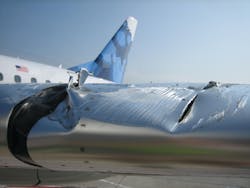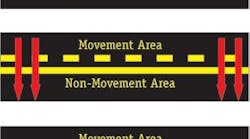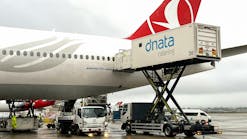How To Avoid Distractions On The Ramp Using The '3 Cs & A NO' Approach
Distractions have always been a serious hazard for anyone operating an automobile out on our public roads and highways, but it is also a serious concern that needs to be equally managed for employees working in the fast-paced environment at any airport.
Distractions that the driving public experiences are similar to the common distractions that GSE employees will experience while out on the ramp, in aircraft repair hangars, or driving around the airport on roadways in the Aircraft Operations Area.
Similar to operating your own motor vehicle, GSE employees face three main types of distractions;
- Visual – Distractions that take your eyes off the road.
- Manual – Distractions that take your hands off the steering wheel.
- Mental/Cognitive – Distractions that take your mind off what you are doing or away from a task.
Just like on the public roadways and highways, common distractions in the AOA are talking/texting on cell phones or listening to music with headphones/ear buds, which is strictly prohibited in the AOA.
By focusing on a few important elements of behavior, however, such as our manual, visual, and mental performance, aircraft damages and employee injuries can be prevented.
It is also worth noting that ground support equipment is used not just for getting from one part of the airport to another. GSE comes in various shapes and sizes and performs different functions essential to aircraft ground operations.
That variety of ground support equipment will have its unique qualities when it comes to handling, clearance heights and specific job function. Operators of such equipment must be cognizant of the differences in controls, attachments and safety features of each type of GSE.
Working in an airport environment is filled with many distractions especially when driving on the ramp. Airport employees can drive on public roads and highways comfortably without any incidents, but often times lose focus while driving in the distraction-filled airport environment resulting in aircraft damage or employee injury.
Aircraft damages related to distractions and loss of situational awareness cause unnecessary disruptions to flight schedules, which can be an inconvenience to airlines’ loyal customer base.
It is important not to underestimate distractions as one of the sources of errors. By reducing errors, such as being distracted and taking shortcuts, risks for airline employees will be reduced and a negative effect on the operation can be eliminated.
One common method for mentally organizing driving tasks of GSE (as well as your personal vehicle) is recognizing five important driving elements we refer to as "3 Cs & a NO:
COMMUNICATION
The most important technique of defensive driving is communication with other drivers or pedestrians in the airport ramp environment.
There is no better form of communication than to establish eye contact with other operators reducing the threat of an incident while driving GSE. The mutual recognition of each other’s presence should be acknowledged and an agreement with a gesture or hand signal as to what each plans to do will avoid any incident.
The purpose of observation is to see; the purpose of communication is to be seen, in other words, recognized and understood. Distractions by hand-held devices, such as cell phones and personal music players, limit the driver’s attention that is needed for effective communication.
COORDINATION
Another defensive driving technique is coordinating your speed and direction of movement with that of the other vehicles on the ramp.
Good coordination depends upon knowing the clearances, turning radiuses, braking capabilitoes and other operating characteristics of the specific piece of equipment you are operating.
It means controlled speed, following at a safe distance and the willingness to yield the right of way to other drivers, if there has been a breakdown in communication or a lack of observation or distraction on the part of the other driver.
CONSIDERATION
This can also be termed "courtesy." Consideration should be shown toward all employees working at any airport regardless of individual job function while driving in the AOA.
NAVIGATION
This is also one of the more important techniques of defensive driving in the airport ramp environment. Unlike driving on the public roads and highways, on an airport ramp few, if any, navigation aids exist.
The defensive driver does not need lane markings or other aids that drivers on public roads do. Becoming familiar with the servicing layout of different aircraft types and the difference between various airport gates and ramps, hangars and remote aircraft parking areas, will reduce the risk of a driving incident or accident.
OBSERVATION
The defensive driver needs to continually stay aware of what is happening on all sides of the vehicle. Because of the high noise levels on the ramp, your sense of hearing is limited as a warning device. By observing these five important driving techniques, operational threats and negative behavioral risks will be reduced.
Operational risk management limits distractions and helps maintain situational awareness; taking time to slow down when necessary will also help eliminate the mindset of operational performance pressures.
Keeping focus on all surrounding threats, including other employees, other aircraft and GSE (stationary or in motion) will help ensure your personal safety, and the safety of your fellow employees.
Part of growing safety culture at any organization is continually monitoring and assessing safety programs and encouraging front line employees to have a voice in the development and implementation of these programs. Constant safety communications to employees serve as effective reminders but can also highlight important human factors elements that airline employees need to effectively manage.
As the saying goes…”Don’t take unnecessary risks, use operational risk management.”
About the author: Kevin P. Crowley, an analyst for ground safety programs, JetBlue Airways Corp., started on the ramp in Buffalo, NY, in 1993. He's been with JetBlue for 12 years and began as an instructor at JetBlue University and taught aircraft servicing for the A320 and E190. He has additional experience in HAZMAT and dangerous goods; winter ops and deicing; and is a certified OHSA instructor.






